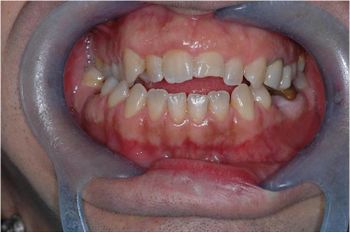Correction chapters
Correction chapters
==Introduction to the Logic of Medical Language== In the previous chapter on the "Logic of Medical Language", we shifted the focus from symptoms or clinical signs to an encrypted machine language. The arguments of Donald E. Stanley, Daniel G. Campos, and Pat Croskerry are relevant, especially when linked to time as an information vector and to the idea of a message as machine language rather than verbal. [1][2]
Nevertheless, clinical history based on pseudo-formal verbal language remains essential. The idea of a machine language and system logic offers an opportunity to validate Medical-Diagnostic Science.
(A bit of patience, please)
We cannot limit ourselves to conventional answers. Science progresses through questions and reflections. This drives us to explore key topics, such as "Craniofacial Biology".
Craniofacial Biology An influential study by Townsend and Brook[3] challenges research paradigms in "Craniofacial Biology", especially with the interdisciplinary approach. Innovations such as gene sequencing, CT, MRI, laser scanning, and image analysis are transforming the field. [4]
The complexity of biological systems is also recognized, influenced by diversity and epigenetics.[5] The role of epigenetics in craniofacial biology has been critically explored, especially in dental and craniofacial disciplines.[6]
Phenomics (the study of the interaction between genetics and environment) is fundamental to understanding dental development.[7] Moreover, Irma Thesleff’s work on transient signaling centers in dental epithelium underlines the complexity of tooth development.[8]
Other researchers have explored dental development processes and the contribution of stem cells and tissue engineering in periodontal regeneration.[9][10]
Variations in tooth development, morphology, and the role of tongue pressure on craniofacial growth further highlight the significance of interdisciplinary approaches.[11][12]
Practical Case Returning to Mary Poppins, diagnosed with TMD, the dentist’s conclusions about her condition are based on classical language logic, but questions arise. Through the analysis of diagnostic data, such as stratigraphy, axiography, and electromyography, it becomes clear that these findings diverge from the conventional approach. Figures 1b, 1c, and 1d illustrate this discrepancy, showing symmetrical motor evoked potentials and mandibular responses that challenge the traditional malocclusion diagnosis.
Mathematical Formalism To understand the complexity of diagnosing Orofacial Pain, mathematical logic can clarify how classical language may fail. Using propositions, we construct formal arguments that either confirm or contradict the dentist's diagnosis.
Propositions in Dental Context If Mary Poppins' TMJ stratigraphic exam shows signs of TMD, the dentist deduces that she suffers from Orofacial Pain caused by TMD. This can be represented mathematically as:
implies that a positive TMJ exam leads to a diagnosis of TMD. However, proof by contradiction can challenge this. If it were possible that someone with a positive exam does not have TMD, the dentist’s argument would not hold.
Compatibility and Incompatibility of Statements The dentist’s conclusion is based on several statements: TMJ bone remodeling, sensitivity and specificity of axiographic measurements, and EMG interference patterns. Each statement supports the diagnosis of TMD.
However, these assertions can be contested. For example, a neurologist might propose that Mary’s Orofacial Pain is neuromotor in origin, not related to TMD. Using logical tools, we analyze whether the two sets of statements—dental and neurological—are compatible. If they are incompatible, the dentist's diagnosis could be invalid.
Final Considerations The application of mathematical logic strengthens the dentist's deductive reasoning. Still, as research evolves, new theories could emerge that align with the neurologist’s position. For now, classical logic favors the dentist’s interpretation, but future findings might shift this understanding, leading to a re-evaluation of Orofacial Pain diagnostics.
(It’s possible.)
- ↑ Stanley DE, Campos DG, «The logic of medical diagnosis», in Perspect Biol Med, 2013».
- ↑ Croskerry P, «Adaptive expertise in medical decision making», in Med Teach, 2018».
- ↑ Townsend GC, Brook AH, «The face, the future, and dental practice», in Aust Dent J, 2014».
- ↑ Sperber GH, Sperber SM, «The genesis of craniofacial biology», in Aust Dent J, 2014».
- ↑ Brook AH, Brook O'Donnell M, «General and craniofacial development», in Aust Dent J, 2014».
- ↑ Williams SD, Hughes TE, «Epigenetics: a new frontier in dentistry», in Aust Dent J, 2014».
- ↑ Yong R, Ranjitkar S, «Dental phenomics: advancing genotype to phenotype correlations», in Aust Dent J, 2014».
- ↑ Thesleff I, «Current understanding of tooth formation», in Aust Dent J, 2013».
- ↑ Peterkova R, Hovorakova M, «Three‐dimensional analysis of the early development of the dentition», in Aust Dent J, 2014».
- ↑ Han J, «Stem cells, tissue engineering and periodontal regeneration», in Aust Dent J, 2013».
- ↑ Brook AH, «The Dentition: The Outcomes of Morphogenesis», in Aust Dent J, 2014».
- ↑ Kieser JA, «The role of oral soft tissues in swallowing function», in Aust Dent J, 2013».
particularly focusing on the field of the neurophysiology of the masticatory system


